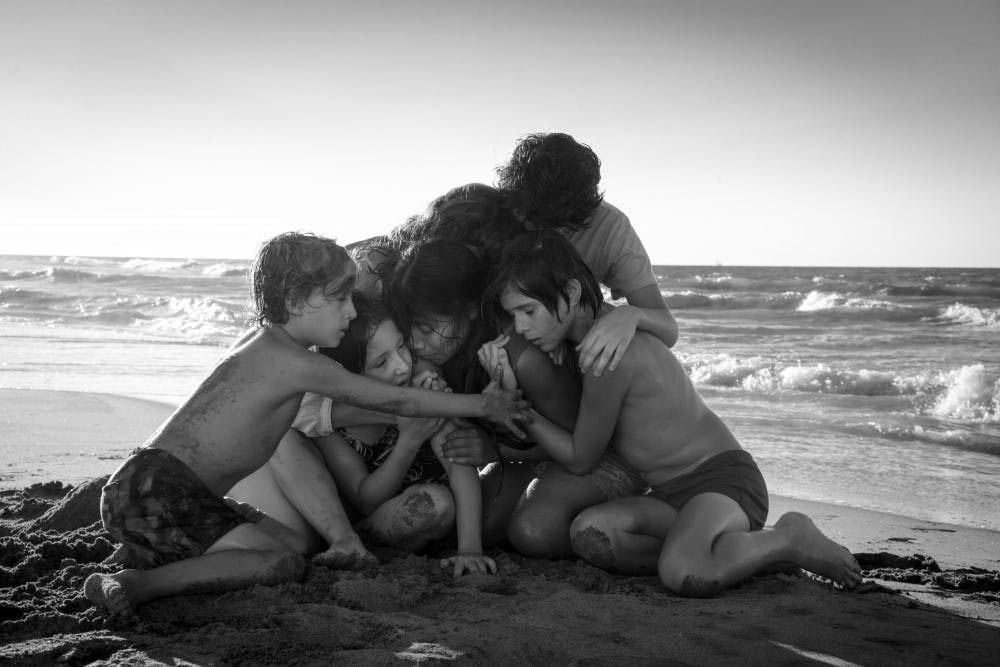Alfonso Cuarón’s Roma opens up on the gentle sound of soapy water gliding against tile, with abstract waves of foam dancing in monochrome for minutes before the film introduces its central figure, Cleo Gutiérrez (Yalitza Aparicio), a young woman who serves as an in–house domestic worker for an upper–middle–class household in 1970s Mexico City. The camera sweeps the interior spaces of the home around which Cleo’s life is centered, catching glimpses of the many rooms that house the family’s four children. The gentle observation of Cuarón’s camera (the Academy Award winning director also served as the film’s cinematographer and editor) is present in all aspects of the film. Naturalistic editing links moments like threads of memory, with dialogue that is sparse but masterfully integrated into a story that is simultaneously melancholy and hopeful.
While the family that Cleo serves confronts a series of its own challenges, they throw the blows that Cleo must take over the course of the film, which she does with grace but not without quiet pain evident to the audience. Tension simmers mostly offscreen and manifests only occasionally, when the calm that we grow accustomed to is shattered suddenly by the sting of reality. When Sofia, Cleo’s employer, drunkenly attempts to park the family’s Ford Galaxie in their driveway, the sound of its sides scraping against the narrow walls is jarring. As Cleo stands reliably at the doorway, Sofia announces that all women are alone in the end, a notion that means so much more than just a drunken rant to both the women, having been wronged by men in ways that force sudden change in their lives.
Roma removes itself from explicit demonstration of the themes that weave in and out of the intimate family drama. The poetry of the film, beyond its visual splendor, is that life itself distills the grander forces that shape the world for its characters. The implications of class, race, sex, and occupation as they pertain to the relationship between Cleo and the family she serves are ever–present, but generally go unmentioned. They are discussed in fleeting moments—in the passing comments of a loving but ignorant child or the sharpness of a command from a pressed employer. Although Cleo is a quiet protagonist, she never wavers from her position as our point of access into Cuarón’s vision. At the same time, her perspective isn’t presented in a way that is cut and dry—instead, it subtly illuminates the Mexico of the 1970s. The meticulousness of every motion is an invitation to observe and reflect.

Roma, Photo by Carlos Somonte/Courtesy of Netflix
At it its core, Roma revels in realism—it is Cuarón’s ode to his upbringing, grounded in memory, shaped by experience, and crafted with a love that is up to par with the intimate bonds that hold together the film’s central family. The way each shot is framed and every beam of light is captured by the camera illuminates the textures of the world Cuarón has brought to us. The film eases in slowly with lingering takes that construct a space that reflects the director’s childhood home. The story begins with a kind of charming nothingness, or what appears to be a stream of establishing moments that are deceptively detached, without a commanding score to tie them together. The sounds of life dominate where dialogue and music take a back seat. Somehow, this perfectly orchestrated world is one that feels too real, as Cleo and the members of her household move in and out of a frame that lingers, pans, and sweeps, capturing the density of the life that inhabits it. What one would ordinarily consider a cinematic symbol or motif is simply a part of the family’s world, and its recurrence a reflection of the truth, not a formulation to feed audiences a prepackaged set of ideas.
Roma’s accessibility as a Netflix film is both a blessing and a curse. Its enrapturing beauty and sensitivity towards visual storytelling begs for the big screen, but still commands the viewer from the convenience of a smaller one. Every moment shared between Cleo and the people that surround her—from her fellow maid, Adela, with whom she speaks Mixtec and does evening exercises by candlelight, to an aching Sofia for whom she is both a servant and confidant, and, of course, the children she showers with tenderness and love as if they were her own—is an exploration of how a woman can be so intimately tied to the people she works for, yet simultaneously set miles apart from them. As these questions arise, they are quickly absorbed into the vibrant tapestry that is Roma—a mirror for memory, as open to contemplation as our own personal histories.

